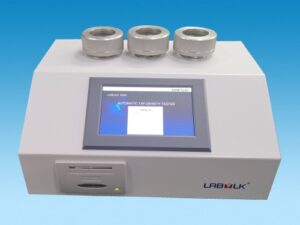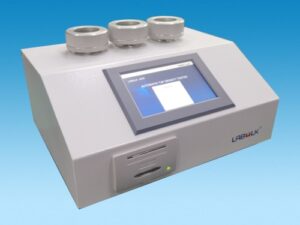The Tapped Density and the Compacted Density 335-2001091315
Bulk density is defined as the weight per unit volume of powder dusts or powder material measured immediately after they are freely filled in a container. Bulk density is divided into loose bulk density and tapped bulk density.
The loose bulk density includes the average density of the loose particle piles in the inner and outer pores and the voids between the particles, which is obtained by dividing the total mass of the unconsolidated granular materials in the natural packing state by the total volume of the packed materials.
The tapped bulk density does not include the inner and outer pores and inter-particle voids. It is the average density of the pelletized body after tapping. The smaller the bulk density, the larger the particle size.
Bulk density: Bulk density: Bulk density refers to the weight per unit volume of a granular material or a powdery material in a natural packing state
.——Bulk density : Natural packing volume (including the voids between materials) The granular material just fills the container, and the volume V of the container is measured.
Formula: ρ0’= m/ V =m /(V0+ VP + Vv )
Of which,ρ0’=Material’s bulk density, kg/ m3
VP= volume of pores inside the particles, m3.
Vv — volume of voids between particles, m3.
V0— the volume of a particle that does not contain an internal void pore m3
Note: The volume in the natural packing state contains the pore volume inside the particle and the void volume between the particles.
(True density refers to the actual volume of solid matter in the volume of material under absolute compactness, excluding internal voids)
(Tapped density)
Definition: The tap density refers to the weight per unit volume of the powder in the container after tapping under specified conditions, and the unit is g / cm3. The tap density is determined by a special tap density instrument..
The tap density is an important indicator for measuring active materials, because the volume of a lithium-ion battery is limited. If the tap density is too low, then the mass of active material per unit volume must be very small, so the volume capacity is very low! Some technology products are so small, the battery inside is even smaller. If the tap density is too low, it definitely won’t work! Therefore, we must pursue higher tap density.
(compacted density)
Definition: the compacted density = area density / (thickness of pole pieces after rolling—thickness of current collector) in the design process of lithium ion battery, unit: g / cm3
The compacted density is divided into: the anode density and the cathode compaction density.
During the manufacture of lithium-ion power batteries, the compaction density has a greater impact on battery performance. It is proved through experiments that the compaction density is closely related to the specific capacity, efficiency, internal resistance, and cycle performance of the battery. Finding the optimal compacted density is important for battery design. Generally speaking, the larger the compacted density is, the higher the capacity of the battery can be. Therefore, the compacted density is also regarded as one of the reference indicators of the material energy density. The compacted density is not only related to the size and density of the particles, but also to the grade of the particles. Generally, the material with higher compacted density has a good particle distribution. It can be considered that under certain conditions, the larger the compaction density, the higher the battery capacity.
The experiment concluded that the proper cathode density can increase the discharge capacity of the battery, reduce internal resistance, reduce polarization loss, extend the cycle life of the battery, and improve the utilization rate of the lithium ion battery. When the compacted density is too large or too small, it is not conducive to the insertion and extraction of lithium ions.
For the cathode materials (lithium cobaltate, lithium manganate, lithium iron phosphate, ternary materials, etc.) and anode materials (artificial graphite, natural graphite, composite graphite, etc.) currently used, due to different materials, there is a large difference in compacted density. .
Relationship between the two:
There is no relationship between the tapped density and the compacted density itself. The only difference is that their measurement methods are different, and the corresponding indicators are also different. They are both an index used to measure the density of the material to determine the volume of the material! Powder companies pay more attention to tapping, while battery companies pay more attention to compaction. The tap density is greatly affected by particle size distribution and particle morphology. Compacted density is affected by true density and effective density. Generally speaking, a high tap density may result in a high compacted density, but it may be necessary to consider the particle size distribution of the powder and the surface morphology of the powder. For the same material, the compacted density is greater than the tapped density.
Tapped density tester https://www.aimsizer.com



